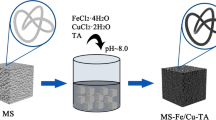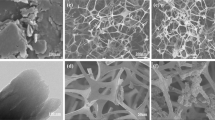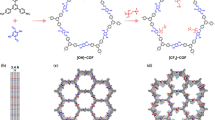Abstract
Water-insoluble organic pollutants in environment, such as sea oil spill, industrial reagents, and the abused organic pesticides, bring great risks to global water systems, which thus requires effective approaches for organic pollutant elimination. In this study, we report a catalytic metal–organic framework (MOF)-melamine foam (MF) composite material (DDT-UiO-66-NH2@MF) showing excellent oil–water separation performance and enzyme-like degradation ability toward organophosphorus pesticides. The fabrication of DDT-UiO-66-NH2@MF is based on the immobilization of a MOF-derived nanozyme (UiO-66-NH2) on MF sponge, and followed by the hydrophobic modification of UiO-66-NH2 by 1-dodecanethiol (DDT). The obtained DDT-UiO-66-NH2@MF thus displayed superhydrophobic/superhydrophilic property with a high water contact angle (WCA = 144.6°) and specific adsorption capacity toward various oils/organic solvents (62.2–119.8 g/g), which leads to a continuous oil–water separation on a simple device. In the meanwhile, owing to the enzyme-like property of UiO-66-NH2, DDT-UiO-66-NH2@MF also displayed good ability to hydrolyze paraoxon under mild conditions, which facilitates the elimination of toxic pesticide residuals in water systems. This work provides a simple, efficient, and green approach for the separation and treatment of water-insoluble organic pollutants, as well as expands the use of MOFs-MF sponge composite materials in environmental sustainability.








Similar content being viewed by others
Data availability
All data generated or analyzed during this study are included in this published article and supplementary information.
References
Awad FS, Bakry AM, Ibrahim AA, Lin A, El-Shall MS (2021) Thiol- and amine-incorporated UiO-66-NH2 as an efficient adsorbent for the removal of mercury(II) and phosphate ions from aqueous solutions. Ind Eng Chem Res 60(34):12675–12688. https://doi.org/10.1021/acs.iecr.1c01892
Bavykina A, Kolobov N, Khan IS, Bau JA, Ramirez A, Gascon J (2020) Metal-Organic Frameworks in heterogeneous catalysis: recent progress, new trends, and future perspectives. Chem Rev 120(16):8468–8535. https://doi.org/10.1021/acs.chemrev.9b00685
Cui J, Xie A, Yan Z, Yan YS (2021) Fabrication of crosslinking modified PVDF/GO membrane with acid, alkali and salt resistance for efficient oil-water emulsion separation. Sep Purif Technol 265:118528. https://doi.org/10.1016/j.seppur.2021.118528
Du H, Liu D, Wu H, Xia W, Zhang XD, Chen ZJ, Liu YJ, Liu HL (2016) Surface modification of nickel sulfide nanoparticles: towards stable ultra-dispersed nanocatalysts for residue hydrocracking. ChemCatChem 8(8):1543–1550. https://doi.org/10.1002/cctc.201600092
Feng DW, Gu ZY, Li JR, Jiang HL, Wei ZW, Zhou HC (2012) Zirconium-metalloporphyrin PCN-222: mesoporous metal-organic frameworks with ultrahigh stability as biomimetic catalysts. Angew Chem Int Edit 51(41):10307–10310. https://doi.org/10.1002/anie.201204475
Gupta RK, Dunderdale GJ, England MW, Hozumi, (2017) A Oil-water separation techniques: a review of recent progresses and future directions. J Mater Chem A 5(31):16025–16058. https://doi.org/10.1039/C7TA02070H
Guo HS, Yang J, Xu T, Zhao WQ, Zhang JM, Zhu YN, Wen CY, Li QS, Sui XJ, Zhang L (2019) A robust cotton textile based material for high flux oil-water separation. ACS Appl Mater Interfaces 11(14):13704–13713. https://doi.org/10.1021/acsami.9b01108
Haruna K, Saleh TA, Obot IB, Umoren A (2019) Cyclodextrin-based functionalized graphene oxide as an effective corrosion inhibitor for carbon steel in acidic environment. Porg Org Coat 128:157–167. https://doi.org/10.1016/j.porgcoat.2018.11.005
Hou YJ, An HY, Zhang YM, Hu T, Yang W, Chang SZ (2018) Rapid destruction of two types of chemical warfare agent simulants by hybrid polyoxomolybdates Modified by Carboxylic Acid Ligands. ACS Catal 8(7):6062–6069. https://doi.org/10.1021/acscatal.8b00972
Islamoglu T, Chen ZJ, Wasson MC, Buru CT, Kirlikovali KO, Afrin U, Mian MR, Farha OK (2020) Metal-Organic Frameworks against toxic themicals. Chem Rev 120(16):8130–8160. https://doi.org/10.1021/acs.chemrev.9b00828
Islamoglu T, Ortuno MA, Proussaloglou E, Howarth AJ, Vermeulen NA, Atilgan A, Asiri AM, Cramer CJ, Farha OK (2018) Presence versus proximity: the role of pendant amines in the catalytic hydrolysis of a nerve agent simulant. Angew Chem Int Edit 57(7):1949–1953. https://doi.org/10.1002/anie.201712645
Katz MJ, Moon SY, Mondloch JE, Beyzavi MH, Stephenson CJ, Hupp JT, Farha OK (2015) Exploiting parameter space in MOFs: a 20-fold enhancement of phosphate-ester hydrolysis with UiO-66-NH2. Chem Sci 6(4):2286–2291. https://doi.org/10.1039/c4sc03613a
Kehe K, Szinicz L (2005) Medical aspects of sulphur mustard poisoning. Toxicology 214(3):198–209. https://doi.org/10.1016/j.tox.2005.06.014
Kriipsalu M, Marques M, Nammari DR, Hogland W (2007) Bio-treatment of oily sludge: The contribution of amendment material to the content of target contaminants, and the biodegradation dynamics. J Hazaed Mater 148(3):616–622. https://doi.org/10.1016/j.jhazmat.2007.03.017
Lee H, Dellatore SM, Miller WM, Messersmith PBJS (2007) Mussel-inspired surface chemistry for multifunctional coatings. Science 318(5849):426–430. https://doi.org/10.1126/science.1147241
Lin F, Li S, Li Y, Li H, Zhang L, Jin Z, Song Y, Liu B, Lei J, Zhu D (2003) Super-hydrophobic surfaces: from natural to artificial. Adv Mater 14(24):1857–1860. https://doi.org/10.1002/adma.200290020
Liu X, Qi W, Wang YF, Su RX, He ZM (2018) Exploration of intrinsic lipase-like activity of zirconium-based metal-organic frameworks. Eur J Inorg Chem 41:4579–4585. https://doi.org/10.1002/ejic.201800898
Manchisi J, Matinde E, Rowson NA, Simmons MJH, Simate GS, Ndlovu S, Mwewa B (2020) Ironmaking and steelmaking slags as sustainable adsorbents for industrial effluents and wastewater treatment: a critical review of properties, performance, challenges and opportunities. Sustainability-Basel 12(5):1–47. https://doi.org/10.3390/su12052118
Moon SY, Liu YY, Hupp JT, Farha OK (2015) Instantaneous hydrolysis of nerve-agent simulants with a six-connected zirconium-based Metal-Organic Frameworks. Angew Chem Int Edit 54(23):6795–6799. https://doi.org/10.1002/anie.201502155
Postma A, Yan Y, Wang YJ, Zelikin AN, Tjipto E, Caruso F (2009) Self-polymerization of dopamine as a versatile and robust technique to prepare polymer capsules. Chem Mater 21(14):3042–3044. https://doi.org/10.1021/cm901293e
Qiu WZ, Yang HC, Xu ZK (2018) Dopamine-assisted co-deposition: An emerging and promising strategy for surface modification. Adv Colloid Interfac 256:111–125. https://doi.org/10.1016/j.cis.2018.04.011
Roy S, Suresh VM, Maji TK (2016) Self-cleaning MOF: realization of extreme water repellence in coordination driven self-assembled nanostructures. Chem Sci 7(3):2251–2256. https://doi.org/10.1039/C5SC03676C
Shen LJ, Wu WM, Liang RW, Lin R, Wu L (2013) Highly dispersed palladium nanoparticles anchored on UiO-66-NH2 Metal-Organic Frameworks as a reusable and dual functional visible-light-driven photocatalyst. Nanoscale 5(19):9374–9382. https://doi.org/10.1039/c3nr03153e
Shi JX, Huang WP, Han HJ, Xu CY (2021) Pollution control of wastewater from the coal chemical industry in China: Environmental management policy and technical standards. Renew Sust Energ Rev 143:110883. https://doi.org/10.1016/j.rser.2021.110883
Shi MB, Huang RL, Qi W, Su RX, He ZM (2020) Synthesis of superhydrophobic and high stable Zr-MOFs for oil-water separation. Colloids Surf A Physicochem Eng Asp 602:125102. https://doi.org/10.1016/j.colsurfa.2020.125102
Smith BM (2008) Catalytic methods for the destruction of chemical warfare agents under ambient conditions. Chem Soc Rev 37(3):470–478. https://doi.org/10.1039/b705025a
Wang JH, Huang RL, Qi W, Su RX, He ZM (2022) Preparation of amorphous MOF based biomimetic nanozyme with high laccase and catecholase-like activity for the degradation and detection of phenolic compounds. Chem Eng J 434. https://doi.org/10.1016/j.cej.2022.134677
Wang Y, Chen A, Peng M, Tan D, Liu X, Shang C, Luo S, Peng L (2019) Preparation and characterization of a fluorizated kaolin-modified melamine sponge as an absorbent for efficient and rapid oil-water separation. J Clean Prod 217:308–316. https://doi.org/10.1016/j.jclepro.2019.01.253
Wei YC, Wang MF, Qi W, He ZM (2022) Flame-resistant bifunctional MOF-based sponges for effective separation of oil-water mixtures and enzyme-like degradation of organic pollutants. Process Saf Environ 163:636–644. https://doi.org/10.1016/j.psep.2022.05.072
Wen MY, Li JM, Zhong WC, Xu J, Qu SH, Wei H, Shang L (2022) High-throughput colorimetric analysis of nanoparticle-protein interactions based on the enzyme-mimic properties of nanoparticles. Anal Chem 94(24):8783–8791. https://doi.org/10.1021/acs.analchem.2c01618
Wu LL, Pu HB, Huang LJ, Sun DW (2020) Plasmonic nanoparticles on Metal-Organic Frameworks: A versatile SERS platform for adsorptive detection of new coccine and orange II dyes in food. Food Chem 328:127105. https://doi.org/10.1016/j.foodchem.2020.127105
Xing YY, Chen ML, ShenXA Liang N, Hou XH (2022) Fe-MIL-88A hexagonal rods as peroxidase mimetic at neutral pH for one-pot glucose colorimetric assay. Chinese J Anal Chem 50(6):100096. https://doi.org/10.1016/j.cjac.2022.100096
Zeng Z, Taylor SE (2020) Facile preparation of superhydrophobic melamine sponge for efficient underwater oil-water separation. Sep Purif Technol 247:116996. https://doi.org/10.1016/j.seppur.2020.116996
Zeng X, Cai W, Fu S, Lin X, Lu Q, Liao S, Hu H, Zhang M, Zhou C, Wen X, Tan S (2022) A novel Janus sponge fabricated by a green strategy for simultaneous separation of oil-water emulsions and dye contaminants. J Hazaed Mater 424:127543.https://doi.org/10.1016/j.jhazmat.2021.127543
Zhang GL, Zhang JH, Su PC, Xu ZH, Li WB, Shen C, Meng Q (2017) Non-activation MOF arrays as a coating layer to fabricate a stable superhydrophobic micro/nano flower-like architecture. Chem Commun 53(59):8340–8343. https://doi.org/10.1039/c7cc03409a
Zhang N, Bao T, Gao Y, Xu XL, Wang SC (2022) Growth of MOF@COF on corncob as effective adsorbent for enhancing adsorption of sulfonamides and its mechanism. Appl Surf Sci 580:152285. https://doi.org/10.1016/j.apsusc.2021.152285
Zhang X, Shi F, Niu J, Jiang YG, Wang ZQ (2008) Superhydrophobic surfaces: from structural control to functional application. J Mater Chem 18(6):621–633. https://doi.org/10.1039/b711226b
Zhang YN, Zhang N, Zhou S, Lv X, Yang CY, Chen W, Hu YB, Jiang W (2019) Facile preparation of ZIF-67 coated melamine sponge for efficient oil-water separation. Ind Eng Chem Res 58(37):17380–17388. https://doi.org/10.1021/acs.iecr.9b03208
Zhou PZ, Cheng J, Yan YY, Xu SP, Zhou CL (2021) Ultrafast preparation of hydrophobic ZIF-67/copper mesh via electrodeposition and hydrophobization for oil-water separation and dyes adsorption. Sep Purif Technol 272:118871. https://doi.org/10.1016/j.seppur.2021.118871
Funding
This study was supported by the National Natural Science Foundation of China (22178260, 21621004).
Author information
Authors and Affiliations
Contributions
All authors contributed to the study conception and design. Material preparation, data collection, and analysis were performed by Xiaoxiao Yu and Yicui Wei. The first draft of the manuscript was written by Xiaoxiao Yu, revised by Mengfan Wang. Work supervised by Mengfan Wang and Wei Qi. All authors commented on previous versions of the manuscript. All authors read and approved the final manuscript.
Corresponding author
Ethics declarations
Ethical approval
This study does not contain any studies with human or animal subjects performed by any of the authors.
Consent to participate
Not applicable.
Consent for publication
All authors have read and agreed to the published version of the manuscript.
Conflict of interest
The authors declare no competing interests.
Additional information
Responsible Editor: George Z. Kyzas
Publisher's note
Springer Nature remains neutral with regard to jurisdictional claims in published maps and institutional affiliations.
Supplementary Information
Below is the link to the electronic supplementary material.
Continuous separation of light oil-water mixture by DDT-UiO-66-NH2@MF sponge (MP4) Supplementary file1 (MP4 9859 KB)
Continuous separation of heavy oil-water mixture by DDT-UiO-66-NH2@MF sponge (MP4) Supplementary file2 (MP4 17052 KB)
Rights and permissions
Springer Nature or its licensor (e.g. a society or other partner) holds exclusive rights to this article under a publishing agreement with the author(s) or other rightsholder(s); author self-archiving of the accepted manuscript version of this article is solely governed by the terms of such publishing agreement and applicable law.
About this article
Cite this article
Yu, X., Wei, Y., Qi, W. et al. Catalytic metal–organic framework-melamine foam composite as an efficient material for the elimination of organic pollutants. Environ Sci Pollut Res 30, 44266–44275 (2023). https://doi.org/10.1007/s11356-023-25441-7
Received:
Accepted:
Published:
Issue Date:
DOI: https://doi.org/10.1007/s11356-023-25441-7




